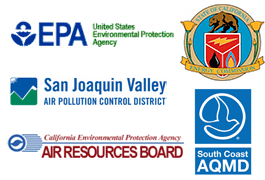About the Clean Air Technology Initiative (CATI)
- What is the Aim of the CATI?
- Who Oversees the CATI?
- How Did the CATI Begin?
- Objectives and Desired Outcomes
- Members and Partners
What Is the Aim of the CATI?
Two regions of California experience some of the highest air pollution levels in the entire United States: the San Joaquin Valley and South Coast air basins. Accelerating progress on this public health challenge requires an all-out team effort – while also maintaining sensitivity to each region's unique demographic and air quality profiles.
Who Oversees the CATI?
The CATI is spearheaded by five public agencies— US Environmental Protection Agency (US EPA), California Air Resources Board (CARB), California Energy Commission (CEC), San Joaquin Valley Air Pollution Control District (SJVAPCD), and South Coast Air Quality Management District (SCAQMD)— to align resources to accelerate cleanup solutions in the form of advanced clean technologies. Staff from the core CATI agencies, along with other public sector partners, oversee collaborative research, development, demonstration and deployment projects intended to commercialize technologies that enable National Ambient Air Quality Standards (NAAQS) attainment.
How Did the CATI Begin?
On July 9, 2008, representatives from US EPA, the California Environmental Protection Agency (Cal/EPA), CARB, SCAQMD, and SJVAPCD signed a Memorandum of Agreement (MOA). In 2011, the CEC joined the CATI as an ex-officio partner. The CATI was founded with the goal of improving air quality by aligning agency research resources to: 1) evaluate innovative and emerging emission reduction technologies, and 2) accelerate the development and deployment of low and zero emission technologies through interagency collaboration.
Objectives and Desired Outcomes
- Projects in the San Joaquin Valley and South Coast air basins that minimize air pollution through advance technologies, tools and policies.
- Showcase integrated approaches (addressing criteria air pollutants, air toxics, and greenhouse gas emissions) in highly impacted communities, to serve as a model for other areas facing nonattainment and environmental justice challenges.
- Expedite technology development and commercialization of technologies to meet the State Implementation Plan and other clean air objectives.
- Facilitate the deployment of low and zero emission technology in selected communities.
- Foster opportunities for green jobs and sustainable business development.

